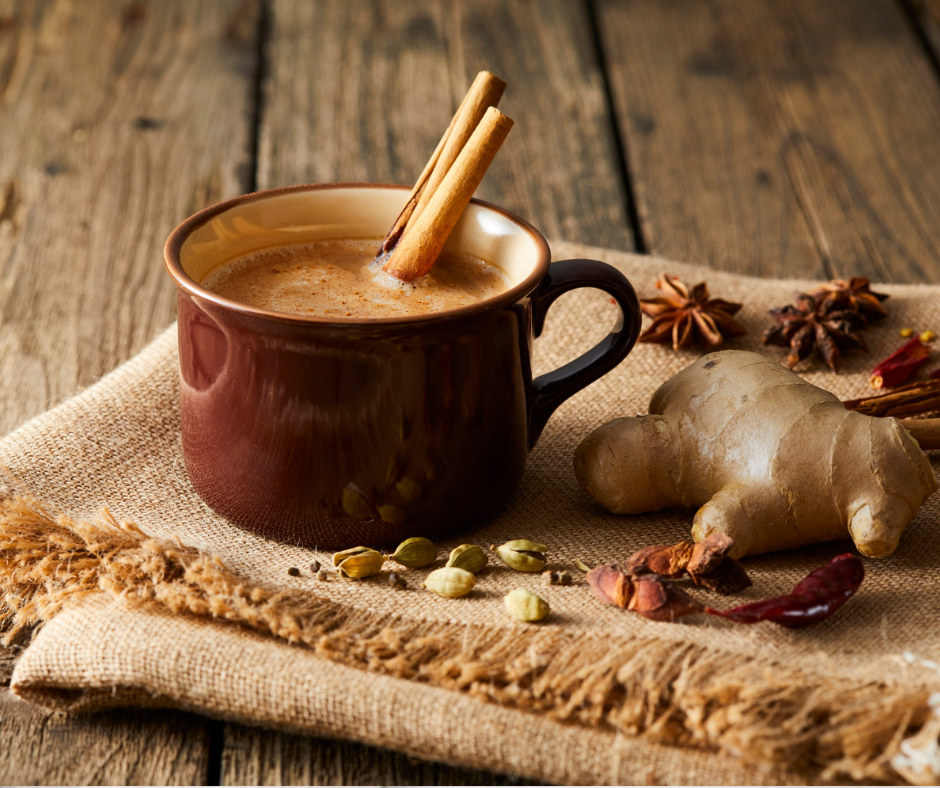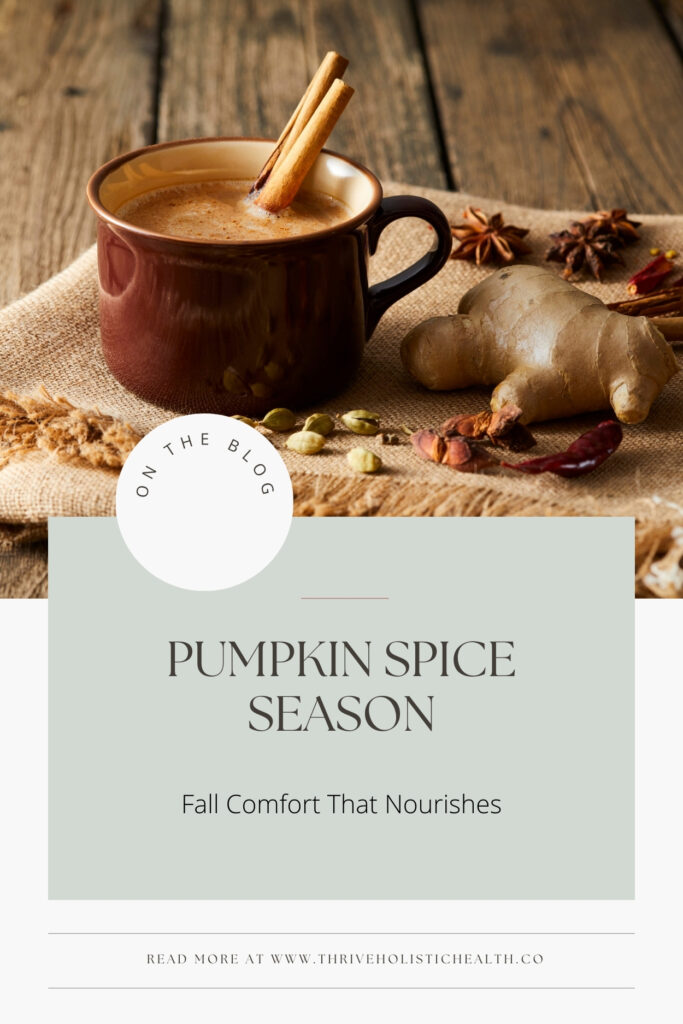Read Our Favorites
HORMONES
GUT HEALTH
SKIN HEALTH
BEAUTY
HEALTHY TRAVEL
WELLNESS
Pumpkin Spice Season: Fall Comfort That Nourishes

There’s something about the first cool morning of fall that makes us want to reach for all things pumpkin spice. Sweaters, crunchy leaves, and cozy mugs- it’s no wonder this flavor has become the unofficial taste of October. But if you’ve ever noticed yourself feeling sluggish, moody, or bloated after indulging in seasonal treats, you’re not alone.
The truth is, pumpkin spice season can either work with your body or against it. The difference lies in how you approach it. Let’s talk about the science behind why we crave these flavors, what’s really happening in the body, and how you can embrace the cozy side of fall without sacrificing your energy, mood, or gut health.
Why We Crave Pumpkin Spice in the Fall
The change in seasons has a real, measurable effect on our biology:
- Shorter days = less sunlight. As the days get darker, serotonin levels naturally dip, which can leave us reaching for comforting foods that give a quick “happy” boost.
- Cooler weather = more carb cravings. Our bodies instinctively crave heavier, energy-dense foods as a way to prepare for winter- an evolutionary survival mechanism.
- Warming spices = built-in benefits. Cinnamon, nutmeg, clove, and ginger aren’t just flavorful. They’ve been used for centuries in traditional medicine to support digestion, immunity, and circulation.
And pumpkin itself? It’s rich in beta-carotene (a precursor to vitamin A), fiber for gut health, and potassium for muscle and nerve function. So the base ingredients of pumpkin spice season are actually supportive. The problem isn’t the pumpkin- it’s what we’ve done to it.
Where It Goes Wrong
Most pumpkin spice treats on store shelves (and often in our coffee shop cups) come loaded with:
- Refined sugar and syrups spike blood sugar, leading to energy crashes, cravings, and inflammation.
- Refined flour is low in fiber, contributing to blood sugar swings and gut imbalances.
- Additives and preservatives can stress the liver and immune system.
When this becomes a daily habit, the fallout adds up:
- Hormone imbalances. Blood sugar spikes push insulin higher, and insulin resistance makes it harder for sex hormones to stay balanced. This is especially important for women in perimenopause.
- Gut disruption. Excess sugar feeds inflammatory microbes and yeast, while starving the good bacteria that thrive on fiber.
- Weakened immunity. A high-sugar diet suppresses the immune system- not ideal heading into cold and flu season.
- Energy and mood dips. That “pumpkin spice high” often ends in a crash that leaves you more tired and irritable than before.
So, it’s not pumpkin spice itself that’s the enemy. It’s the sugar-laden delivery system.
A Better Approach
Functional medicine is all about looking at the why behind symptoms and helping the body return to balance. Here’s how we can apply that lens to fall flavors:
1. Hormone Balance
When blood sugar is stable, insulin doesn’t have to work overtime, cortisol stays more even, and your sex hormones (like estrogen and progesterone) can find their natural rhythm. This matters for energy, weight, mood, and even skin.
2. Gut Health
Pumpkin’s fiber feeds beneficial gut bacteria, while spices like cinnamon and clove have antimicrobial properties that can help keep “bad bugs” in check. A healthier microbiome means better digestion, stronger immunity, and less inflammation.
3. Immune Resilience
Vitamin A (from pumpkin’s beta-carotene) is essential for healthy immune cells, while ginger and cinnamon support circulation and help the body fight infections. With fall being prime cold and flu season, these foods can give you an edge.
4. Mind-Body Connection
Fall rituals- sipping tea, baking, lighting candles, walking outside- can calm the nervous system, reduce cortisol, and help shift us into a slower, more restorative rhythm. Your body perceives these signals of safety and responds by healing more deeply.
Cozy, Nourishing Ways to Enjoy Pumpkin Spice
You don’t need to avoid pumpkin spice to stay healthy this fall. Instead, think about how you can keep the cozy and the science in balance.
- Make your own latte. Blend unsweetened almond or coconut milk with real pumpkin puree, pumpkin pie spice, and a touch of maple syrup or monk fruit. Add collagen powder for protein.
- Bake smarter. Swap refined flour for almond or coconut flour, and use less sugar (or natural sweeteners). Pumpkin muffins or bread can actually be a blood sugar–friendly snack when paired with nut butter. Simple Mills brand has really tasty pumpkin bread/muffin mix with great ingredients.
- Spice it up. Remember: it’s not the sugar, it’s the spice. Add cinnamon, nutmeg, ginger, or clove to oats, chia pudding, roasted sweet potatoes, or even savory dishes like chili for flavor + health benefits.
- Pair it with protein and fat. A slice of pumpkin bread with boiled eggs, or a homemade latte with a handful of nuts, slows the glucose release and keeps energy stable.
- Move your body. A short walk after enjoying a seasonal treat can blunt the blood sugar spike by up to 30%. Cozy sweaters + fresh fall air make this a win-win.
Rituals That Ground You This Fall
Food is just one piece of the pumpkin spice puzzle. The season itself invites us to lean into grounding rituals that support whole-body wellness:
- Morning light exposure. Step outside within 30 minutes of waking to balance circadian rhythm and boost mood.
- Evening wind-down. Swap scrolling for tea, reading, or journaling to help your body adjust to longer nights.
- Outdoor walks. Crisp air + movement support both mental clarity and immune strength.
- Nourishing meals. Think soups, stews, roasted veggies, and seasonal produce- foods that warm and heal.
These simple habits signal to your body that it’s safe, supported, and ready for the seasonal shift.
The Takeaway
Pumpkin spice doesn’t have to be a guilty pleasure or a blood sugar bomb. With a holistic perspective, it becomes a chance to:
- Support your hormones
- Strengthen your gut
- Boost your immune system
- Create grounding rituals that help you thrive
So go ahead- light the candles, put on your coziest sweater, and enjoy pumpkin spice season. Just remember: it’s not about avoiding the flavors you love. It’s about making choices that keep your body balanced and your energy steady, so you can fully embrace everything this season has to offer.

Don't wait another day to start feeling better. Let's have a chat about your story and see how we can help!
Begin the transformation
Blood sugar imbalances play a major role in weight gain, hormone issues, chronic pain, and diseases like type 2 diabetes and heart disease. This guide gives you the tools to curb cravings, stabilize energy, and support long-term wellness. Plus, you’ll get a 4-week blood sugar-balancing meal plan and recipe pack to make healthy eating simple and sustainable!